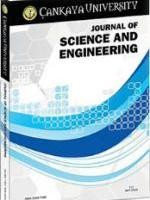On Design and Analysis of Damping Physiognomies of Reinforced Composite Loofah Sponge on Athlete’s Shoe
On Design and Analysis of Damping Physiognomies of Reinforced Composite Loofah Sponge on Athlete’s Shoe
Loofah sponge vibration damping, composite material,
___
- [1] J. H. Shen, M. Xie, X. D. Huang, S. W. Zhou, and D. Ruan, “Compressive behavior of luffa sponge material at high strain rate,” in Key Engineering Materials, 2013, vol. 535, pp. 465–468.
- [2] X. Chen, X. Hao, and S. Zhao, “Dynamic Numerical Analysis of the “Foot–Training Shoe “Model,” Procedia Manuf., vol. 3, pp. 5519–5526, 2015.
- [3] B. Friesenbichler, L. M. Stirling, P. Federolf, and B. M. Nigg, “Tissue vibration in prolonged running,” J. Biomech., vol. 44, no. 1, pp. 116–120, 2011.
- [4] P. A. Ubi and S. A. R. Asipita, “Effect of Sodium Hydroxide Treatment on the Mechanical Properties of Crushed and Uncrushed Luffa cylindrica Fibre Reinforced rLDPE Composites,” World Acad. Sci. Eng. Technol. Int. J. Chem. Mol. Nucl. Mater. Metall. Eng., vol. 9, no. 1, pp. 203–208, 2015.
- [5] G. Genc and H. Körük, “Identification of the Dynamic Characteristics of Luffa Fiber Reinforced Bio-Composite Plates,” 2017.
- [6] D. C. P. Quinayá and J. R. M. D’almeida, “Nondestructive characterization of epoxy matrix composites reinforced with Luffa lignocellulosic fibers,” Matéria (Rio Janeiro), vol. 22, no. 2, 2017.
- [7] K. L. N. Raj and K. G. Ashok, “Design and fabrication of vibration damping pad using Luffa Cylindrica fiber reinforced polymer composite,” Int J Multidiscip Res Mod Educ, vol. 2, no. 1, pp. 441–448, 2016.
- [8] Y. Chen et al., “In-depth analysis of the structure and properties of two varieties of natural luffa sponge fibers,” Materials (Basel)., vol. 10, no. 5, p. 479, 2017.
- [9] A. Franck and T. A. I. Germany, “Viscoelasticity and dynamic mechanical testing,” TA Instruments, New Castle, DE, USA AN004.
- [10] R. H. Pritchard and E. M. Terentjev, “Oscillations and damping in the fractional Maxwell materials,” J. Rheol. (N. Y. N. Y)., vol. 61, no. 2, pp. 187–203, 2017.
- [11] M. Carfagni, E. Lenzi, and M. Pierini, “The loss factor as a measure of mechanical damping,” in Proceedings-spie the international society for optical engineering, 1998, vol. 1, pp. 284–580.
- [12] L. F. Nielsen, “Fatigue of viscoelastic materials such as wood with overload,” 2008.
- [13] N. Chambon, N. Delattre, N. Guéguen, E. Berton, and G. Rao, “Is midsole thickness a key parameter for the running pattern?,” Gait Posture, vol. 40, no. 1, pp. 58–63, 2014.
- [14] M. H. C. Law et al., “Effects of footwear midsole thickness on running biomechanics,” J. Sports Sci., vol. 37, no. 9, pp. 1004–1010, 2019.
- Yayın Aralığı: Yılda 2 Sayı
- Başlangıç: 2009
- Yayıncı: Çankaya Üniversitesi
Blood Glucose Adaptive Generalized Predictive Control for Critical Care Patients
Saeed BALOCHIAN, Gholam Reza ALIKHANI
Solutions of Emden-Fowler type Equations by Variational Iteration Method
Safe and Efficient Path Planning for Omni-directional Robots using an Inflated Voronoi Boundary
Mohammed Rabeea Hashim AL-DAHHAN, Klaus Werner SCHMIDT
Copure Submodules and Related Results
Order-preserving Models for the Supervisory Control of Flexible Manufacturing Systems
